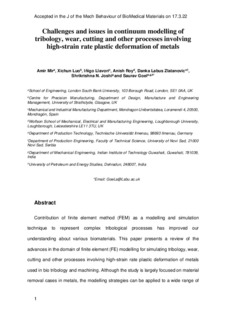Izenburua
Challenges and issues in continuum modelling of tribology, wear, cutting and other processes involving high-strain rate plastic deformation of metalsEgilea
Egilea (beste erakunde batekoa)
Argitalpen data
2022Beste erakundeak
London South Bank UniversityUniversity of Strathclyde
Loughborough University
Technische Universität Ilmenau
University of Novi Sad
University of Petroleum and Energy Studies
Bertsioa
PostprintaDokumentu-mota
ArtikuluaArtikuluaHizkuntza
IngelesaEskubideak
© 2022 Published by Elsevier Ltd.Sarbidea
Sarbide bahituaBahituraren amaiera data
2024-03-31Argitaratzailearen bertsioa
https://doi.org/10.1016/j.jmbbm.2022.105185Non argitaratua
Journal of the Mechanical Behavior of Biomedical Materials Vol. 130. N. artículo 105185, 2022Argitaratzailea
Elsevier Ltd.Gako-hitzak
Finite element
Lagrangian
ALE
Meshless ... [+]
Lagrangian
ALE
Meshless ... [+]
Finite element
Lagrangian
ALE
Meshless
chip formation [-]
Lagrangian
ALE
Meshless
chip formation [-]
Laburpena
Contribution of finite element method (FEM) as a modelling and simulation technique to represent complex tribological processes has improved our understanding about various biomaterials. This paper pr ... [+]
Contribution of finite element method (FEM) as a modelling and simulation technique to represent complex tribological processes has improved our understanding about various biomaterials. This paper presents a review of the advances in the domain of finite element (FE) modelling for simulating tribology, wear, cutting and other processes involving high-strain rate plastic deformation of metals used in bio tribology and machining. Although the study is largely focused on material removal cases in metals, the modelling strategies can be applied to a wide range of other materials. This study discusses the development of friction models, meshing and remeshing strategies, and constitutive material models. The mesh-based and meshless formulations employed for bio tribological simulations with their advantages and limitations are also discussed. The output solution variables including scratch forces, local temperature, residual stresses are analyzed as a function of input variables. [-]





















